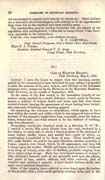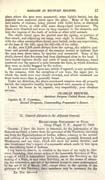
[p. 16]
BREWER’S REPORT
Camp at Mountain Meadows,
Utah Territory, May 6, 1859
Captain: I have the honor to report, that this morning, accompanied by the detachment of men furnished by your orders, I proceeded to inter the remains of the men, women, and children of the Arkansas emigrant train, massacred by the Mormons at the Mountain Meadows, Utah Territory, in the month of September, 1857.
At the scene of the first attack, in the immediate vicinity of our present camp, marked by a small defensive trench made by the emigrants, a number of human skulls and bones and hair were found scattered about, bearing the appearance of never having been buried; also remnants of bedding and wearing apparel.
On examining the trenches or excavations, which appear to have been within the corral, and within which it was supposed some written account of the massacre might have been concealed, some few human bones, human hair, and what seemed to be the feathers of bedding, only were discerned.
Proceeding twenty-five hundred yards in a direction N.15 W., I reached a ravine fifty yards distant from the road, bordered by a few bushes of scrub oak, in which I found portions of the skeletons of many bodies—skulls, bones, and matted hair—most of which, on examination, I concluded to be those of men. Three hundred and fifty yards further on, and in the same direction, another assembly of human remains were found, which, by all appearance, had been left to decay upon the surface. Skulls and bones, most of which I believed to be those of women, some also of children, probably ranging from six to twelve years of age. Here, too, were found masses of women's hair, children's bonnets, such as are generally used upon the plains, and pieces of lace, muslin, calicoes, and other material, part of women's and children’s apparel. I have buried thirteen skulls, and many more scattered fragments.
Some of the remains above referred to were found upon the surface of the ground, with a little earth partially covering them, and at the

[p. 17]
place where the men were massacred; some lightly buried, but the majority were scattered about upon the plain. Many of the skulls bore marks of violence, being pierced with bullet holes, or shattered by heavy blows, or cleft with some sharp-edged instrument. The bones were bleached and worn by long exposure to the elements, and bore the impress of the teeth of wolves or other wild animals.
The skulls found upon the ground near the spring, or position of first attack, and adjoining our camp, were eight in number. These, with the other remains there found, were buried, under my supervision, at the base of the hill, upon the hill-side of the valley.
At the rate 2,500 yards distant from the spring, the relative positions and general appearance of the remains seemed to indicate that the men were there taken by surprise and massacred. Some of the skulls showed that fire-arms had been discharged close to the head. I have buried eighteen skulls and parts of many more skeletons, found scattered over the space of a mile towards the lines, in which direction they were no doubt dragged by the wolves.
No names were found upon any article of apparel, or any peculiarity in the remains, with the exception of one bone, the upper jaw, in which the teeth were very closely crowded, and which contained one front tooth more than is generally found.
Under my direction, the above-mentioned remains were all properly buried, the respective locality being marked with mounds of stone.
I have the honor to be, captain, very respectfully, your obedient servant.
CHARLES BREWER, Assistant Surgeon United States Army. Captain R. P. Campbell, Second Dragoons, Commanding Paymaster's Escort.